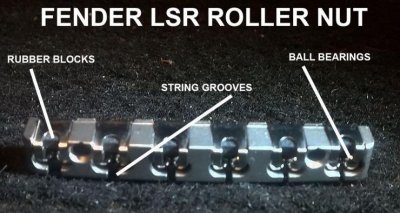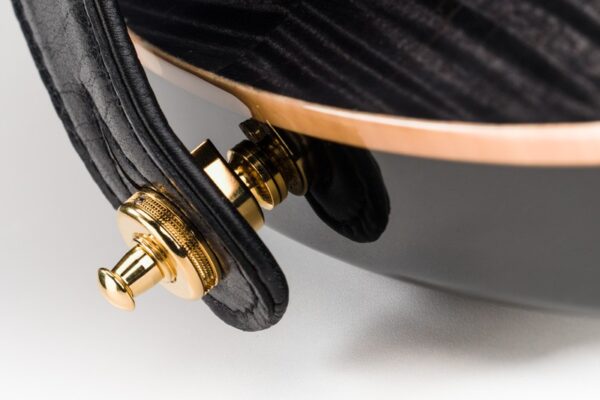Table of Contents
Guitar nuts are an important component to get the right tuning stability and to make sure you can a tremolo without worrying about your tuning. This is one of the reasons roller nuts are so popular.
They allow you to use and abuse the tremolo, without having to retune your guitar every time you dive bomb.
In this guide we will go over some of the most important questions you might have about roller nuts and if you should get one in your guitar.
What is a guitar roller nut?
The guitar roller nut is a device that replaces the traditional nut on the fretboard of a guitar. The roller nut is made up of a series of small rollers that sit in between the strings and the neck of the guitar. This design helps to keep the strings in tune longer by reducing friction.
It also allows for easier playing and can provide a tighter feel on the strings. The roller nut also helps to keep the strings in tune by reducing friction.
Roller nuts have become extremely popular for Stratocasters and superstrats. Instead of using a Floyd Rose with a locking nut, the roller nut allows you to also use the tremolo without the tuning being affected.
Who invented the roller nut?
The guitar roller nut was invented by Fender in conjunction with Floyd Rose. The idea was to create a guitar that you could use the tremolo as a Floyd Rose but without the disadvantage of having a locking nut.
For guitar players who need to change the tuning from song to song, a locking nut is very limiting. It basically means that for each different tuning you will need a new guitar. This is when the LSR rolling nut was born.
How does a roller nut work?
A guitar roller nut works by using two small rollers that sit on either side of the nut. When the strings are depressed, they roll over the top of the nut which helps to keep them in place and results in long-lasting tuning stability.

What does a roller nut do?
It is a cylindrical piece of metal or plastic with small rollers on it that allow the strings to glide smoothly as they are tuned. This helps to keep the strings in tune and makes it easier to use the tremolo without the guitar going out of tune.
By reducing the friction between the nut and the string. This is accomplished by replacing the traditional nut with a roller that contacts the string at a tangent point, as opposed to the perpendicular point of contact created by a traditional nut.
What is the most popular roller nut?
The Fender LSR is by far the most popular roller nut available. However, it is on the pricey side, but there are cheaper alternatives that will produce pretty much the same results.
Guyker seems to be a popular brand, and its roller nut is a lot cheaper than Fender’s LSR.
Wilkinson also makes terrific guitar parts, including the roller nut.
Should you get a roller nut?
If you are constantly using your tremolo, and you do not want a locking nut, a roller nut is probably the best solution for you.
It allows you to use the tremolo without your guitar going out of tune, and it is easy to constantly. Even if you do not use the tremolo all the time, it is still worth considering getting a roller nut. It will do wonders for your tuning stability.
You will also don’t have to worry about using the tremolo here and there without the guitar sounding out of tune.
How do you install a roller nut?
Although you can install a guitar roller nut yourself, it is always better to have a luthier do it. Especially if you do not have a lot of experience with changing parts on a guitar.
Additionally, a typical nut is rounded, and it is thinner than a roller nut. Therefore in most guitars, you will have to sand the nut area and make it larger. Roller nuts also tend to be thicker and this requires even more sanding.
Roller nuts are also applied with 2 screws, which means you need to gently drill the neck of the guitar.
For these reasons, it is always better to take your guitar to an experienced luthier who can do the job easily, and without anything happening to your beloved guitar.
However, if you still want to do it here are the steps you need to take:
How to install a roller nut step-by-step:
- Take the strings off your guitar
- Remove the nut of your guitar
- Check if you will need to cut and sand to have enough space for the new nut
- Make sure the roller nut stays tight
- Make the holes for the roller nut
- Install the roller nut
- Restring the guitar
Take the strings off your guitar
The first thing you need to do to install a roller nut is to take the strings off the guitar, so you can work with it.
Remove the nut of your guitar
The next step is to remove the nut of your guitar. If you use a thin file to push the nut it should come off easily. However, some nuts may be difficult to remove like this. Since they are glued to the guitar. In this case, you should keep applying pressure and increase it until the nut finally slides.
Cutting and sanding
Since most guitar nuts are thinner and also rounded you will need to sand the wood underneath the nut. So that when you place the roller nut it actually fits in, and it stays in place.
This can be very different for different guitar models, because not every guitar is the same. This is certainly one of the most complicated parts of replacing a traditional nut with a roller nut.
Make sure the roller nut stays tight
Once you have filled and sanded the guitar nut area you need to make sure that the nut is tight and it won’t come out easily. Since the roller nut is going to be screwed into the guitar neck it may not seem important, but you want to make sure that the nut does not have a lot of room to move around.
Make the holes for the roller nut
Once you have placed the nut, you can use a pen to mark the spots where you need to drill. Once again you need to be extremely careful because if you do not do it correctly you can damage your guitar neck.
Install the roller nut
Once you have made the holes you can screw your new roller nut into it. Some luthiers will use a little bit of glue to make sure the nut does not move around, and you may want to consider doing the same.
Restring the guitar
Finally, you just need to restring the guitar, and you can start playing and using the tremolo without worrying about tuning!
Here is a video showing each step in detail:
Advantages of using a guitar roller nut
There are a lot of advantages of using a roller nut instead of a traditional nut. It should be said that if you have a guitar with a tremolo bar and you intend to use it frequently a roller nut is a must. Here are some of the main advantages:
- Less friction on the nut
- Easy to use the tremolo bar without the guitar going out of tune
- The guitar stays in tune for longer
- No need to lubricate or file the nut
Less friction on the nut
A roller nut allows for less friction on the nut, which makes the strings move freely. This makes it easy to use a tremolo bar without worrying that your guitar will be out of tune.
Easy to use the tremolo bar without the guitar going out of tune
The biggest advantage of a roller nut is the ability to use the tremolo as much as you want and really go crazy with it, without your guitar going out of tune. As guitar players, we know how frustrating it can be to use the tremolo and have to retune the guitar.
With a roller nut, and the right setup you can dive bomb as much as you want without the guitar going out of tune.
The guitar stays in tune for longer
Additionally, a roller nut also allows your guitar to stay in tune for a longer time. This saves you time, and the worry of thinking you are out of tune.
A roller nut does not require any filing or shaping. It also performs better, as it allows the strings to glide smoothly over the nut, reducing friction and improving tuning stability. It can also be adjusted to accommodate different string gauges, making it a versatile option for every guitar player.
No need to lubrificate the nut
A lot of guitar players try to file their nut and lubricate it so that the strings slide easily. With a roller nut, you do not need to worry anymore about your nut. It works great, and it does not affect the tone.
It is an easy and simple way of improving the tuning stability, and it is also an affordable addition to any guitar.
Disadvantages of using a guitar roller nut
One of the few disadvantages of a roller nut is that the playing will feel slightly different. The way the roller nut is designed makes the strings feel stiffer and tighter.
This is one of the only drawbacks of roller nuts.
Does a roller nut change the tone of the guitar?
While a roller nut can change how long your guitar stays in tune, and it can affect the action of the strings, it does not change the tone of the guitar.
The main reasons guitar players get a roller nut is the improved tuning, and the ability to use a tremolo without worrying the guitar will go out of tune.
Roller nut vs bone nut
A roller nut is a type of guitar nut that uses small rollers to guide the strings over the nut, as opposed to using a zero-fret or a traditional nut. A bone nut is a type of guitar nut that is made from animal bones. They are often considered to be superior to other types of nuts because they are denser and therefore produce a clearer tone.
However, one major difference between a roller nut and a bone nut is that the roller nut can help your guitar stay in tune for longer periods. A bone nut will also require you to do some maintenance, like using lubricant, and filing the nut slots.
Conclusion
Roller nuts are an interesting alternative to traditional guitar nuts, with clear advantages, especially if you use a tremolo bridge often. If you use the tremolo bar a lot, you might want to consider a roller nut.
Your guitar will stay in tune for a long time, and you can dive bomb as much as you want so that your guitar won’t go out of tune. If you are considering a roller nut, you should also consider locking tuners to make sure your tuning is super solid.
Ultimately, it is up to you to decide if a roller nut is right for your playing.

I have been playing guitar for the past 15 years, and my knowledge and passion for guitars prompted me to start Guitaresque to share my knowledge, tips, and tricks with other guitar players. The sole purpose of this website is to help and inspire guitar players worldwide, to improve their playing and their love for guitars.










